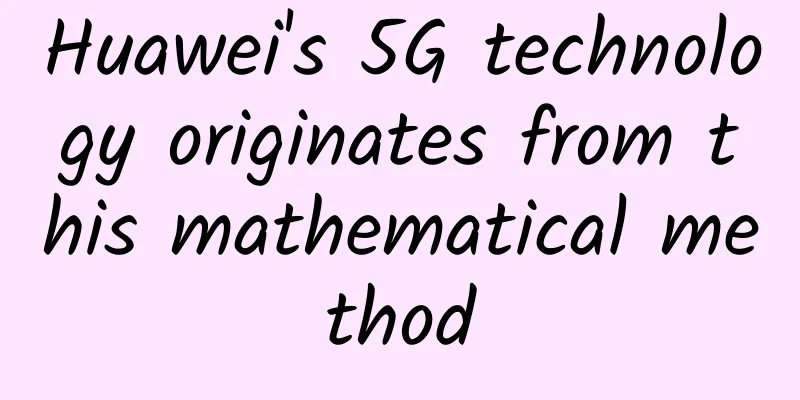Huawei's 5G technology originates from this mathematical method

|
Recently, after Huawei was hit by US trade sanctions, Ren Zhengfei's statement attracted the attention of major media. Ren Zhengfei is full of confidence in Huawei's 5G technology: "Huawei's 5G will definitely not be affected. In terms of 5G technology, other countries will definitely not catch up with Huawei in two or three years." It is worth noting that Ren Zhengfei mentioned in an interview that Huawei's achievements in 5G are inseparable from the contribution of a Turkish scientist: "The 5G standard originated from a mathematical paper written by Professor Alekan of Turkey more than ten years ago...", "In ten years, we turned the Turkish professor's mathematical paper into technology and standards." So what did this Turkish scientist do, and how does it relate to Huawei's 5G technology? 5G Basics: Polar Codes Erdal Arikan was born in Ankara, the capital of Turkey, in 1958, but he spent most of his school life in the United States. In 1981, Arikan obtained his undergraduate degree from the California Institute of Technology, and then he went to another famous university in the United States, the Massachusetts Institute of Technology, and received his doctorate in electronic information engineering in 1985. It is worth mentioning that Arikan's doctoral supervisor was American Professor Robert Gallager. Gallager's supervisor, that is, Arikan's master, was the famous information theory founder Shannon. In this sense, Arkan has a distinguished academic background. After graduating with a doctorate and returning to his hometown of Bilkent University in Turkey, Arkan developed groundbreaking technology. At Bilkent University, a not-so-famous university, Arkan worked hard for ten years and finally succeeded in 2008, publishing a polarization code technology solution mainly used for 5G communication coding. The paper he published was in the IEEE journal in 2008. The article was 23 pages long, but he was the only author. After this article was published, it was noticed by Huawei. Huawei has many scientists with strong research capabilities. They evaluated Alkan's paper and realized that it was crucial because the technology in it could be used in 5G coding.
Ren Zhengfei presented the award to Arkan to pay tribute to his outstanding contribution to the development of human communications. Therefore, Huawei contacted Alekhan, applied for a number of patents based on this technology, and blocked a number of patents based on Alekhan's polarization code. The international competition among technology companies is a battle for patents and interests, and it is necessary to strike first. What is the mathematical principle of polarization code? You can read the article below. You probably need some basic knowledge of communication and coding to understand it. Of course, if you have knowledge of linear algebra or group theory, you can definitely understand the principle of polarization code by just spending some time. In fact, polar codes look complicated, but in essence they are still some matrix multiplications. For example, if you want to encode the 4-bit [u 1 u 2 u 3 u 4 ] with polar codes, you will get another 4-bit signal (codeword) [x 1 x 2 x 3 x 4 ] , which is equivalent to the following matrix multiplication: 5G standards: a battle between master and apprentice After Huawei developed 5G communication technology based on polarization codes, it faced the crucial 5G standard vote - if it wins, it will have the right to speak on the 5G communication network. In last year's 5G standard voting, the polarization code advocated by Huawei was blocked by Qualcomm, a US company, which advocated the low-density parity-check (LDPC) code . The originator of LDPC code was none other than Alkan’s mentor Gallagher. Therefore, behind this dispute over 5G communication standards is a technical dispute between a master and his apprentice. Of course, on the surface it is a technical dispute, but behind it is also a dispute over national interests. Communications giants such as Qualcomm in the United States naturally prefer the coding method proposed by the Americans, but newcomers in the communications industry such as Huawei also hope to gain a first-mover advantage in the formulation of this international standard. In the formulation of the 5G standard, after a complex game, a compromise was finally formed: LDPC code becomes the coding scheme for the data channel; polar code becomes the coding scheme for the control channel. Therefore, this is a realistic result. Although Huawei did not win completely, it did not lose completely either. The same is true for Qualcomm. The ultimate result is that everyone will develop 5G together and no one will kick anyone out. From a technical perspective, LDPC was invented in 1963, but was largely ignored for more than 30 years due to the limitations of the hardware conditions at the time and the lack of a feasible decoding algorithm. However, with the advancement of technology, especially after the discovery of Turbo codes by Berlu et al. in 1993 and their use in 3G and 4G communications, people were inspired by Turbo codes and improved LDPC codes. It was found that LDPC codes perform better than Turbo codes. Therefore, LDPC code is considered to be a relatively mature and old coding scheme, and its effect is indeed good. However, the advantage of polarization code is that it requires less calculation and can be implemented with small-scale chips, which is more suitable for 5G small base stations. In addition, the hardware using this coding method has low equipment cost after commercialization, so it is also the most competitive. Control Channel As mentioned above, the polarization code promoted by Huawei is mainly used for 5G control channel coding. What does this mean? The control channel is used to transmit instructions and synchronize data. It is like when we turn on the computer, the computer needs to read the information on the hard disk, which requires the hard disk to be powered on. This power-on process is transmitted by the control signal. So, to put it simply, Huawei's 5G polarization code solution has won the "right to control the power supply of computer hard drives" rather than the "right to transfer movie data on hard drives." In terms of data volume, the control channel has a much smaller data volume, and the code block length is generally between 20-300 bits. This is like if you don’t want to transmit high-definition movie data, but just want to turn on the computer, you don’t need so much data to complete the task of turning it on. The code block length of the 5G data channel is much longer, with a typical data volume of between 3000 and 8000 bits, and there are a lot of code blocks, and the amount of data transmitted is several orders of magnitude higher than that of the control channel. Therefore, in terms of data volume, LDPC codes have a greater victory, but this does not mean that polar codes have failed. After all, polar codes are a newcomer and have not been tempered in practice, so we can only wait until 5G is commercially available on a large scale before we can evaluate whether the superiority of polar codes is really good. For polar codes, the encoding complexity of a data block of length N is O(N log N). According to Shannon's criterion, this has reached the maximum limit of 5G coding. Therefore, Huawei is optimistic about the future of polarization codes because it has great theoretical advantages. Moreover, Huawei has already gone a long way in the industrialization of 5G. Therefore, it is not difficult for us to understand Huawei's confidence: because it has mastered the technology, even if it encounters a trade war, Huawei has the confidence to win. |
<<: Huawei Mate 20 Pro removed from Android Q list, no hope for update?
Recommend
You can create a hit and increase your followers even without any Douyin experience
Douyin can create a hit even without any basic kn...
The Ministry of Industry and Information Technology announced the second batch of apps that infringe on user rights, including Lagou, Tianya, etc.
It is becoming increasingly difficult for apps th...
Windows 10 is best with 8GB of RAM
It is an absolute truth that more memory can impr...
Young man digging graves and stealing corpses at midnight: I am here to bury Caesar |
Modern historiography seems to have become a conv...
10 things to know about Tik Tok live streaming!
Accompanying entrepreneurs in the entertainment i...
Is breast milk no longer nutritious after 10 months? Can smoking prolong your life? Here are the scientific rumors for March
1. Alcohol and hand sanitizer can inactivate noro...
15-day easy calligraphy training course video tutorial
15-day easy calligraphy training course video tut...
More than 100 years ago, this Chinese scientific genius had published a paper in Nature
Publishing a paper in Nature is the goal pursued ...
Build a developer community operation strategy from scratch!
The author of this article starts from user portr...
What are To B data products and operations?
In recent years, with the continuous popularizati...
Trivia about how the ancients repelled mosquitoes
Annoying mosquitoes are not only a headache for m...
Cooling spray has a bad temper and may be flammable and explosive!
Even though the beginning of autumn has passed, t...
What are the techniques for search bidding mobile promotion? Here are 8 suggestions for you
What are the techniques for search bidding mobile...
Five paths to building a TOB brand
When I was thinking about the issues of TOB brand...









